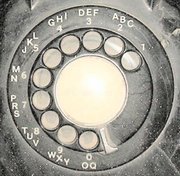Dial
In telephony and telecommunications in connection with a telephone, a dial refers, in older telephones, to a rotating disk with 10 numbered finger holes. When a particular numbered hole is rotated with the finger to a finger stop set at a specific point across the dial, then released, the dial mechanism rotates the dial back to its original position and transmits pulses down the telephone line according to the number of the hole selected. more...
Nowadays the dial is a key pad, generally with 12 keys numbered 0-9, *, and # that perform an equivalent signalling function to that of a rotating disk dial.
In telephony, the word dialing (in present and past tense spelt with two "l"s in British English and with one in American English) describes the process of the placement of a telephone call.
History
From as early as 1836, there were various suggestions and inventions of dials for sending telegraph signals. After the first commercial telephone exchange was installed in 1878, the need for a telephone dial became apparent. The first telephone dial patent was jointly issued to Connolly and McTighe in 1879. There were numerous competing inventions, and 26 patents of dials, push-buttons and similar mechanisms for signalling which telephone subscriber was wanted by a caller were issued prior to 1891. Most involved highly complex, and expensive, mechanisms and required the user to perform complex manipulations.
The first commercial installation of a Telephone Dial accompanied the first commercial installation of a 99 line automatic telephone exchange in La Porte, Indiana in 1892, which was based on the 1891 Strowger patent designs. The original dial designs were rather cumbersome and development continued during the 1890s and early 1900s hand in hand with the switching technology. In the 1950s, invention of plastics saw the dial itself change from metal disk to a plastic ring.
The dial numbering can occur in 4 different formats, with 0 either being placed next to the 1 or the 9 and the numbers running in ascending or decending order with either the 0,1 or 9 being closest to the fingerstop. However, the number of pulses sent by the dial remained the same with one hole movement sending one pulse and 10 hole movements sending 10 pulses. All the telephones connected to a particular telephone exchange had to have the same dial numbering. Generally dial numbering was standardised on a countrywide basis, though all 4 dial formats were used.
In the early 1960s Bell Telephone Laboratories researched various key pad layouts to replace the telephone dial, for electronic telephone equipment. Researchers rearranged the dial numbers in a wide range of combinations from mimicking a telephone dial to the now familiar 4 row by 3 column keypad. They found the 4x3 keypad to be the fastest and most error free arrangement to operate. However, because the American telephone dial had the 0 next to the 9, they tested the arrangement with a 1 at the top and 0 at the bottom, below the 8 key. They also tested an arrangement with the 0 below the 2 and having 9 at the top, as appeared on adding machines at that time and now appears on computer and calculator keyboards, but that arrangement was more error prone as few people were familiar with adding machines at that time. Because of this research, phone key pad numbering is reversed to today's calculator and computer keyboards.
Read more at Wikipedia.org



